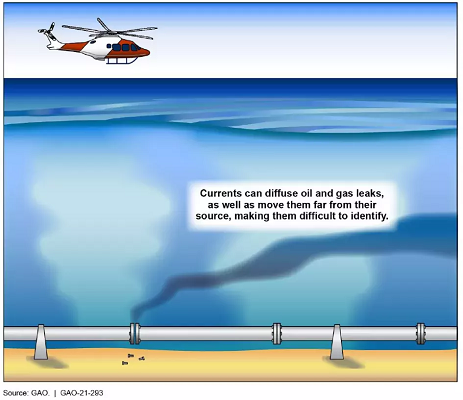A new study1 from the U.S. Government Accountability Office (GAO) (Washington, DC, USA) concludes that a better oversight process is needed to ensure integrity for about 8,600 mi (13,840.4 km) of active offshore oil and gas pipelines in the U.S. Gulf of Mexico. Furthermore, the study finds the Bureau of Safety and Environmental Enforcement (BSEE) (Washington, DC, USA) lacks a robust process to address safety and environmental risks posed by decommissioned pipelines left in place on the seafloor.
 According to GAO, the offshore oil and gas industry has installed approximately 40,000 mi (64,373.8 km) of oil and gas pipelines in federal offshore waters since the 1940s. BSEE is responsible for enforcing standards and regulations for oil and gas operations—including the oversight of active pipelines and their decommissioning—to enhance environmental protection and safety.
According to GAO, the offshore oil and gas industry has installed approximately 40,000 mi (64,373.8 km) of oil and gas pipelines in federal offshore waters since the 1940s. BSEE is responsible for enforcing standards and regulations for oil and gas operations—including the oversight of active pipelines and their decommissioning—to enhance environmental protection and safety.
As pipelines age, they often become more susceptible to damage from corrosion, mudslides, and seafloor erosion, which can result in leakage of oil and gas into the ocean, GAO notes. Additionally, hurricanes can move pipelines extensive distances, which may damage the subsea habitat, impede access to sediment resources, and create navigational and trawling hazards.
Procedural Review
For this study, GAO was asked to review BSEE’s management of offshore oil and gas pipelines. In turn, this report examines BSEE’s processes for ensuring active pipeline integrity, as well as addressing safety and environmental risks posed by decommissioning.
As part of their work, GAO reviewed regulations, procedures, and other documents and data related to BSEE’s pipeline management processes. GAO also interviewed BSEE officials and those from other agencies with offshore responsibilities.
According to the study, BSEE does not generally conduct or require any subsea inspections of active pipelines. Instead, the bureau relies on monthly surface observations and pressure sensors to detect leaks. However, officials told GAO that these methods and technologies are not always reliable for detecting ruptures.
In response to a pair of significant oil leaks in 2016 and 2017, BSEE partnered with industry to improve subsea leak detection. But the identified technologies remain relatively new and cannot be retrofitted to a majority of pipelines, the study notes.
Study Finds Outdated Regulations
According to GAO, BSEE officials believe the bureau’s regulations are outdated and do not address how pipelines should be inspected, nor do they explore the complexities of deep-water pipeline operations and changes in technological standards.
BSEE says it has long recognized the need to improve its pipeline regulations. In 2007, the bureau issued a proposed rule citing the need to enhance safety and protect the environment. However, this effort stalled, according to the study. The 2007 proposed rule addressed offshore pipeline integrity, including new requirements regarding pipeline inspection and subsea leak detection technologies.
Since 2013, BSEE has noted plans to update its pipeline regulations, but the bureau has made only limited progress in the interim. Without taking actions to develop, finalize, and implement updated regulations to address the identified oversight gaps, BSEE will continue to be limited in its ability to ensure the integrity of active pipelines, the study concludes.
Addressing Safety and Environmental Risks
Beyond active pipelines, BSEE also does not have a robust process to address safety and environmental risks that are posed by leaving decommissioned pipelines in place on the seafloor. According to GAO, this is due to oversight gaps before, during, and after the decommissioning process.
First, BSEE does not thoroughly account for such risks during its review of decommissioning applications, GAO explains. This has contributed to BSEE and its predecessors authorizing industry to leave over 97% (about 18,000 mi, or 28,968.2 km) of decommissioned pipeline mileage on the Gulf of Mexico seafloor since the 1960s.
Generally, pipelines must be removed from the seafloor, GAO notes. BSEE, however, can allow pipelines to be decommissioned-in-place if certain criteria are met. Such a high rate of approval indicates that this is not an exception, but that decommissioning-in-place has become the norm for decades.
Second, BSEE does not ensure that operators meet decommissioning standards, such as cleaning pipelines. They do not observe any pipeline decommissioning activities, inspect pipelines after their decommissioning, or verify most of the pipeline decommissioning evidence submitted, the study finds.
Finally, BSEE does not monitor the condition and location of pipelines following their decommissioning-in-place process, which reduces the bureau’s ability to mitigate any long-term risks, such as pipeline exposure or movement. Additionally, if pipelines decommissioned-in-place are later found to pose risks, there is no funding source for removal, according to the study.
To this point, BSEE has made only limited progress in updating what it acknowledges are outdated pipeline regulations, GAO notes. Without taking further actions, GAO believes that BSEE will continue to be limited in its ability to address relevant risks.
Next Steps for BSEE
Based on these conclusions, GAO recommends that BSEE take actions to develop, finalize, and implement updated regulations to address these long-standing limitations. The U.S. Department of the Interior (Washington, DC, USA) agreed with this recommendation, GAO notes.
In September 2021, the Department of the Interior issued an update that BSEE was continuing to work on updates to its offshore oil and gas pipeline regulations and anticipated publishing a final rule in October 2022. In April 2022, BSEE indicated that it has taken a number of actions to update its pipeline regulations but that its timeframes had shifted, with the bureau anticipating publication of a proposed rule in late summer 2022.
Once issued, Materials Performance (MP) magazine will have news coverage of that proposed rule in an upcoming MP print issue and online at materialsperformance.com.
Source: U.S. GAO, www.gao.gov.
Reference
1 GAO-21-293, “Offshore Oil and Gas: Updated Regulations Needed to Improve Pipeline Oversight and Decommissioning,” https://www.gao.gov/products/gao-21-293 (Washington, DC: U.S. Government Accountability Office, April 19, 2021).